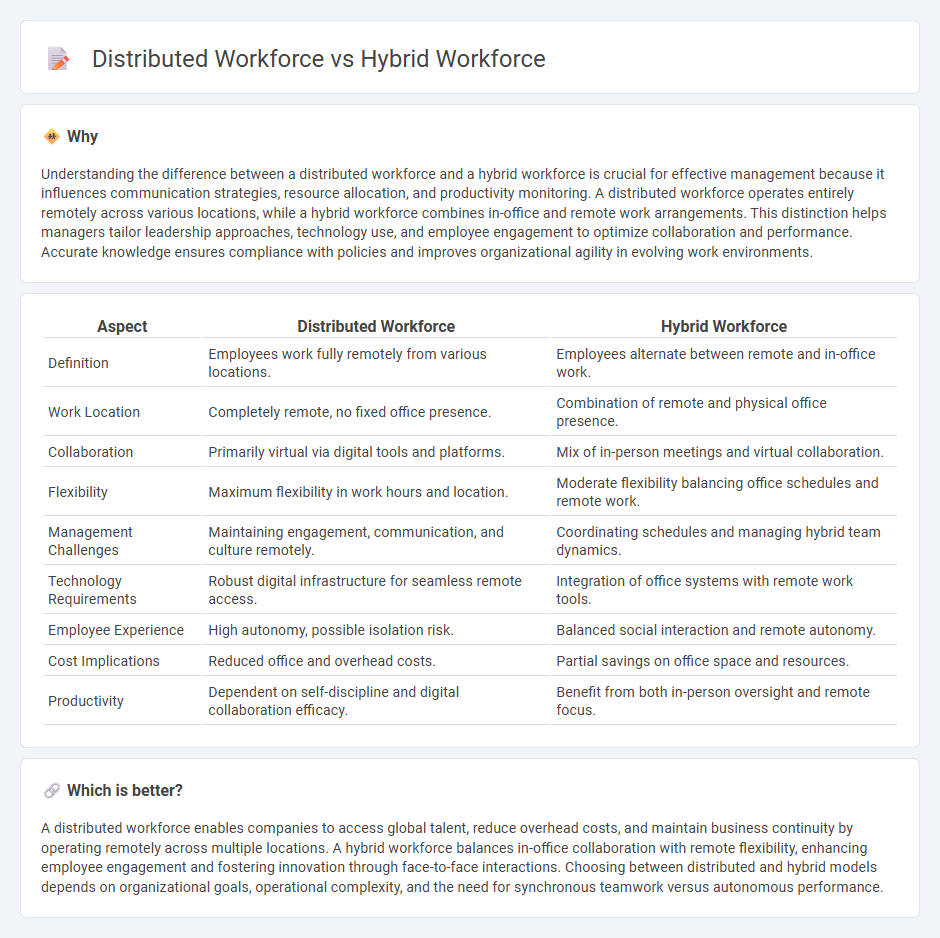
Distributed workforce models leverage fully remote teams operating across diverse locations, enhancing flexibility and access to global talent pools. Hybrid workforce arrangements combine in-office and remote work, promoting collaboration while maintaining employee autonomy and reducing commuting. Explore more to understand which model better aligns with your organizational goals and operational needs.
Why it is important
Understanding the difference between a distributed workforce and a hybrid workforce is crucial for effective management because it influences communication strategies, resource allocation, and productivity monitoring. A distributed workforce operates entirely remotely across various locations, while a hybrid workforce combines in-office and remote work arrangements. This distinction helps managers tailor leadership approaches, technology use, and employee engagement to optimize collaboration and performance. Accurate knowledge ensures compliance with policies and improves organizational agility in evolving work environments.
Comparison Table
| Aspect | Distributed Workforce | Hybrid Workforce |
|---|---|---|
| Definition | Employees work fully remotely from various locations. | Employees alternate between remote and in-office work. |
| Work Location | Completely remote, no fixed office presence. | Combination of remote and physical office presence. |
| Collaboration | Primarily virtual via digital tools and platforms. | Mix of in-person meetings and virtual collaboration. |
| Flexibility | Maximum flexibility in work hours and location. | Moderate flexibility balancing office schedules and remote work. |
| Management Challenges | Maintaining engagement, communication, and culture remotely. | Coordinating schedules and managing hybrid team dynamics. |
| Technology Requirements | Robust digital infrastructure for seamless remote access. | Integration of office systems with remote work tools. |
| Employee Experience | High autonomy, possible isolation risk. | Balanced social interaction and remote autonomy. |
| Cost Implications | Reduced office and overhead costs. | Partial savings on office space and resources. |
| Productivity | Dependent on self-discipline and digital collaboration efficacy. | Benefit from both in-person oversight and remote focus. |
Which is better?
A distributed workforce enables companies to access global talent, reduce overhead costs, and maintain business continuity by operating remotely across multiple locations. A hybrid workforce balances in-office collaboration with remote flexibility, enhancing employee engagement and fostering innovation through face-to-face interactions. Choosing between distributed and hybrid models depends on organizational goals, operational complexity, and the need for synchronous teamwork versus autonomous performance.
Connection
Distributed workforce and hybrid workforce are connected through flexible work arrangements that leverage technology to enable employees to work from multiple locations, combining remote and on-site tasks. Both models require effective communication tools and management strategies to maintain productivity and collaboration across geographically dispersed teams. Emphasizing cloud-based platforms and project management software enhances coordination and supports seamless integration between remote and office-based employees.
Key Terms
Flexibility
A hybrid workforce combines in-office and remote work, offering employees flexibility to choose their work environment based on tasks and preferences, enhancing productivity and work-life balance. A distributed workforce operates entirely remotely across various locations, providing maximum geographic flexibility but requiring robust digital communication and collaboration tools. Explore more about optimizing flexibility in hybrid and distributed work models to empower your team.
Collaboration Tools
Hybrid workforce leverages collaboration tools like Microsoft Teams and Slack to seamlessly integrate in-office and remote employees, enhancing real-time communication and project management. Distributed workforce relies heavily on cloud-based platforms such as Zoom, Google Workspace, and Asana to coordinate efforts across diverse time zones and locations, ensuring continuous productivity and collaboration. Explore how specific collaboration tools can optimize your workforce strategy for better efficiency and connectivity.
Employee Engagement
Hybrid workforce models blend in-office and remote work, enhancing employee engagement by offering flexibility and fostering collaboration during on-site days. Distributed workforces operate fully remotely across diverse locations, prioritizing digital communication tools to maintain connection and engagement. Explore how tailored strategies for each model can boost productivity and employee satisfaction.
Source and External Links
What is a Hybrid Workforce? Meaning, Benefits & ... - A hybrid workforce is a flexible work model combining remote and in-office work, allowing employees to split their time between home and office, with common models including primarily in-office, primarily remote, or split schedules.
What Is a Hybrid Workforce? Meaning & Best Practices - The hybrid workforce allows employees to work on-site, remote, or a combination, gaining popularity post-COVID-19 due to employees seeking better work-life balance and companies adapting to new workforce expectations.
What is a Hybrid Workforce? | Factors and Models - A hybrid workforce consists of on-site and remote employees working collaboratively regardless of location, driven by technological advances and changing employee expectations, with flexible models to optimize productivity and satisfaction.
 dowidth.com
dowidth.com